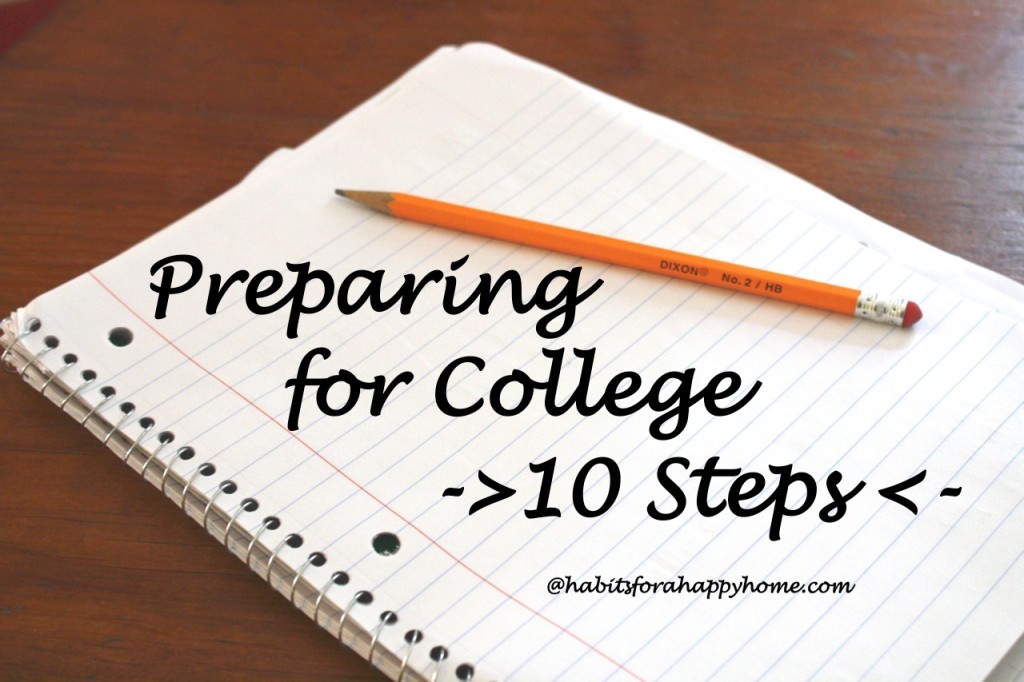
Helping a child apply to college and all that goes along with it can seem overwhelming to any parent, but the homeschool parent has the added responsibility of being the educator as well. You can do it, and without much stress, if you take it one step at a time. Here are 10 steps for preparing for college.
Preparing for College
I’ve outlined below what I did to give my girls a college preparatory education and help them apply to and choose a college.

Grades 9-12
1. Teach college-preparatory courses. Use curriculum designed for the high school level. At this point, you may need to separate older students if you usually teach unit studies involving the whole group. Their material should be meatier and require more study and testing, papers, and projects. Most colleges require a number of years of English and math, two years of foreign language study (the same language both years), and science and history. Electives are also usually required, and at the very least an asset on your child’s transcript.
2. Keep a record of your child’s grades for each subject each year. This will later be the child’s transcript. There are many sample transcripts on the internet that you can pattern yours after. The college my daughter applied to had its own sample on the website. I made mine exactly like theirs and just typed in my daughter’s classes and grades. You can also find a G.P.A. (grade-point average) calculator on the internet. It is important to know your child’s G.P.A., as this affects academic scholarships. The higher the G.P.A., combined with SAT or ACT score, the more scholarship money the college will offer. If your child’s grade are not top-notch, don’t despair… colleges are looking for average students with other abilities as well.
3. Along with the record of grades, I also keep a portfolio of my student’s work. It’s simple: a three-ring binder is divided into sections—one section for each class. After a math test, the student places the graded test into the math section. English papers are put into the English section, and so on. I do not save everything… mostly just tests, quizzes, and papers, and maybe a few pages of daily work. The rest goes into the trash at the end of the school year (but that’s for another post on avoiding clutter).
At the end of the year, the portfolio is finished, except for two tasks:
- I have each child design a cover for the year, including pictures of them throughout, and
- I print a copy of their grades (their “report card”) and put that into the binder as well.
I have never had to show this to a potential college, but we have these to look back over in future years, and they are available just in case.
4. Look for scholarships, as early as ninth grade. Colleges usually offer their own internal scholarships, but there are many more. Websites such as Fastweb customize your scholarship search for you after you fill out a questionnaire. They email scholarship matches, which prevents much wasted time. You can also do a Google search for “scholarships for _____________ “ and fill in the blank with whatever makes you unique. I kid you not, there is actually a scholarship for people who speak Klingon! Also check your local paper. Businesses often provide scholarships for students in the community, and more are becoming open to homeschooled students. Some scholarships require that you give household income, some do not. Apply to as many as you can, but avoid the ones you know you would most likely not win. Also, never apply to scholarships that require money up front. This is usually a scam. Who handles the scholarships? In our house, I find them, and my high schoolers apply.
Grades 11-12
5. Have your child take the SAT or ACT test. I recommend once during the junior year, and once or twice more during the senior year (unless the first score is phenomenal!). Have the scores sent to any college he is interested in (you can send scores to up to four colleges for free). This, combined with the G.P.A., is important in getting into college and getting scholarships both inside and outside the college. I’d have them take one of each, then take the one they scored higher on a second or even third time. Prep classes for these tests can be beneficial as well. These classes are usually geared toward how to take the test rather than a review of the information on the test.
- Collegeboard.com has all the information on the SAT
- actstudent.org has the information for the ACT
6. Have your child choose colleges he’s interested in, and apply to the ones he is really serious about. Check out the college’s website. A visit to campus helps, if that is possible. Talking with current students and alumni is extremely beneficial.
Questions to ask:
- Does this college fit your student?
- Will he feel comfortable there?
- If he will be living away from home, do you feel comfortable with the environment?
- What is the teaching philosophy?
Everyone has their own opinion about choosing a college, but realize that most young people form their life-long friendships and philosophies during college. After homeschooling them with a certain worldview for 12 years, are you comfortable with a philosophy that is diametrically opposed to that? A good school in my opinion will present a number of ideas and opinions but hold to the same worldview my student has been brought up with. Our children made their own decisions, but we guided them toward colleges in this realm. We also made sure the college was accredited, which could be necessary in the future for a graduate to be considered for certain jobs.
7. The FAFSA…. Free Application for Federal Student Aid. This must be filled out each calendar year of college beginning Jan. 1 of the student’s senior year of high school. It’s a good idea for the person who does the taxes in your family to be the one who fills out the FAFSA. My husband does one right after the other (taxes first). Submit the FAFSA to the schools you are applying to as early as possible. We do this for our kids, as they do not handle the family finances, but it’s a good idea to get them involved, at least let them see what you’re doing.
8. Once you’ve received an “award letter” (telling your student how much money he will be awarded in federal aid, scholarships, and student loans), make a decision. Ultimately, our daughter had her heart set on a certain school since age 16, and chose it. Your student may have a more difficult time choosing. This is where the most important aspect comes in … prayer!
9. Apply for special programs – honors, musical ensembles, athletic clubs. Many of these offer extra scholarship money, reducing the student and parent load. Some schools also allow students to register for classes and apply for on-campus jobs online, ahead of time.
10. It’s a good idea to make sure your student has a personal computer before sending him off to college. Sure, the school will have a computer lab, but a PC is almost a must these days. We made our daughter’s her graduation present.
Do you have any questions or concerns about getting your child into college? If you’ve already been through this, what tips do you have for the rest of us?
~Written by Kim, The Daisy Muse
Kim – Thank you so much for putting this all together in a handy guidelines. I’m pinning and saving it for easy reference. What an encouragement you are!
Thank you for these simple steps — while my oldest is just in seventh grade, it’s so good to have resources like this post to save for later!
This is a great list. Thanks for sharing!
IMPOTANT!!!! The FAFSA starts Oct 1 now. If you wait until Jan. 1, you may be too late
You are SO right! Thank you for pointing that out — as this was written several years ago.